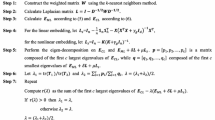Abstract
In this paper, we propose a method to detect abnormal events using a novel unsupervised kernel learning algorithm. The key of our method is to learn a suitable feature space and the associated kernel function of the training samples. By considering the self-similarity property of training samples, we assume that the training samples will show the distinctly clustering property in the obtained feature space. Non-negative matrix factorization (NMF) is used to learn the feature space, and the support vector data description (SVDD) method is adopted to measure the clustering degree of instances in the feature space. We append the clustering constraints in the process of learning the feature space and use the bases produced by NMF as the projection matrix to construct the kernel function in SVDD. In other words, we incorporate the minimal enclosing sphere constraints within the NMF formulation. In the process of feature space learning, instances in the obtained feature space will be described better and better by an hypersphere. Our algorithm converges to a local optimal solution by applying an alternating optimization approach. Experimental results on three public datasets and the comparison to the state-of-the-art methods show that our method is effective in detecting and locating unknown abnormal behaviors.









Similar content being viewed by others
References
Lee, D.D., Seung, H.S.: Learning the parts of objects by non-negative matrix factorization. Nature 401, 788–791 (1999)
Lee, D.D., Seung, H.S.: Algorithms for non-negative matrix factorization. NIPS 13, 629–634 (2001)
Thurau, C., Hlavac, V.: Pose primitive based human action recognition in videos or still images, CVPR, pp. 1–8 (2008)
Tax, D.M.J., Duin, R.P.W.: Support vector data description. Mach. Learn. 54, 45–66 (2004)
Christoph, H., Lampert, C.H.: Kernel methods in computer vision. Found. Trends Comput. Graph. Vis. 4(3), 193–285 (2009)
Cong, Y., Yuan, J., Liu, J.: Sparse reconstruction cost for abnormal event detection. CVPR, pp. 3449–3456 (2011)
Wu, S., Moore, B., Shah, M.: Chaotic invariants of Lagrangian particle trajectories for anomaly detection in crowded scenes. In: CVPR (2010)
Vijay Kumar, B.G., et al.: Max-margin non-negative matrix factorization. Image Vis. Comput. 30, 279–291 (2012)
Ding, C.H.Q., Li, T., Jordan, M.I.: Convex and semi-nonnegative matrix factorizations. IEEE Trans. Pattern Anal. Mach. Intell. 32(1), 45–55 (2010)
Ritter, G., Gallegos, M.T.: Outliers in statistical pattern recognition and an application to automatic chromosome classification. Pattern Recognit. Lett. 18, 525–539 (1997)
Pers, J., et al.: Histograms of optical flow for efficient representation of body motion. Pattern Recognit. Lett. 31, 1369–1376 (2010)
Smola, A.: Learning: with Kernels: support vector machines. MIT Press, Cambridge, MA (2002)
Yuan, J., Liu, Z., Wu, Y.: Discriminative subvolume search for efficient action detection. CVPR, pp. 2442–2449 (2009)
Dalal, N., Triggs, B.: Histograms of oriented gradients for human detection. CVPR, pp. 886–893 (2005)
Cong, Y., Gong, H., Zhu, S., Tang, Y.: Flow mosaicking: real-time pedestrian counting without scene-specific learning. CVPR, pp. 1093–1100 (2009)
Kim, J., Grauman, K.: Observe locally, infer globally: a space-time MRF for detecting abnormal activities with incremental up-dates. In: CVPR (2009)
Kratz, L., Nishino, K.: Anomaly detection in extremely crowded scenes using spatio-temporal motion pattern models. In: CVPR (2009)
Ramin Mehran, M.S., Oyama, A.: Abnormal crowd behavior detection using social force model. In: CVPR (2009)
Beibei Zhan, P.R.S.V., Monekosso, D., Xu, L.-Q.: Crowd analysis: a survey. Mach. Vis. Appl. 19, 345–357 (2008)
Mahadevan, V., Li, W., Bhalodia, V., Vasconcelos, N.: Anomaly detection in crowded scenes. CVPR, pp. 1975–1981 (2010)
Pascual-Montano, J., Carazo, K., Kochi, D., Lehmann, R.D.: Pascual-Marqui, Nonsmooth nonnegative matrix factorization (NSNMF). IEEE Trans. Pattern Anal. Mach. Intell. 28(3), 403–415 (2006)
Zhang, D., Zhou, Z., Chen, S.: Non-negative matrix factorization on kernels, PRICAI. pp. 404–412 (2006)
Bociu, I., Pitas, I.: A new sparse image representation algorithm applied to facial expression recognition, machine learning for signal processing, 2004. Proceedings of the 2004 14th IEEE signal processing society workshop, pp. 539–548 (2004)
Wasserman, L.: All of statistics: a concise course in statistical inference. (2004)
Tropp, J.: Literature survey: non-negative matrix factorization, university of Texas at Austin, preprint (2003)
Singh, K., Upadhyaya, S.: Outlier detection: applications and techniques. Int. J. Comput. Sci. Issues 9(1), 3 (2012)
Han, J., Kamber. M.: Data Mining: Concepts and Techniques, 2nd edn. Elsevier, Amsterdam, pp. 451–460
Fan, H., Zaïane, O. R., Foss, A., Wu, J.: A nonparametric outlier detection for efficiently discovering top-n outliers from engineering data. In: Proceedings of the Pacific-Asia Conference on Knowledge Discovery and Data Mining (PAKDD), Singapore (2006)
Jin, W., Tung, A., Han, J., and Wang, W. Ranking outliers using symmetric neighborhood relationship. In Proceedings of the Pacific-Asia Conference on Knowledge Discovery and Data Mining (PAKDD), Singapore (2006)
Kriegel, H.-P., Schubert, M., Zimek, A.: Angle-based outlier detection. In: Proceedings of the ACM SIGKDD International Conference on Knowledge Discovery and Data Mining (SIGKDD), Las Vegas, NV (2008)
Chapelle, O., Zien, A.: Semi-supervised classification by low density separation. In: Proceedings of the 10th International Workshop on Artificial Intelligence and Statistics, pp. 57–64 (2005)
McLachlan, G.J., Do, K.A., Ambroise, C.: Analyzing microarray gene expression data. Wiley, London (2004)
Acknowledgments
This paper is supported by College of Information System and Management, National University of Defense Technology and subsidized by National Natural Science Foundation of China(Grant No. 61170158).
Author information
Authors and Affiliations
Corresponding author
Rights and permissions
About this article
Cite this article
Ren, W., Li, G., Sun, B. et al. Unsupervised kernel learning for abnormal events detection. Vis Comput 31, 245–255 (2015). https://doi.org/10.1007/s00371-013-0915-0
Published:
Issue Date:
DOI: https://doi.org/10.1007/s00371-013-0915-0




